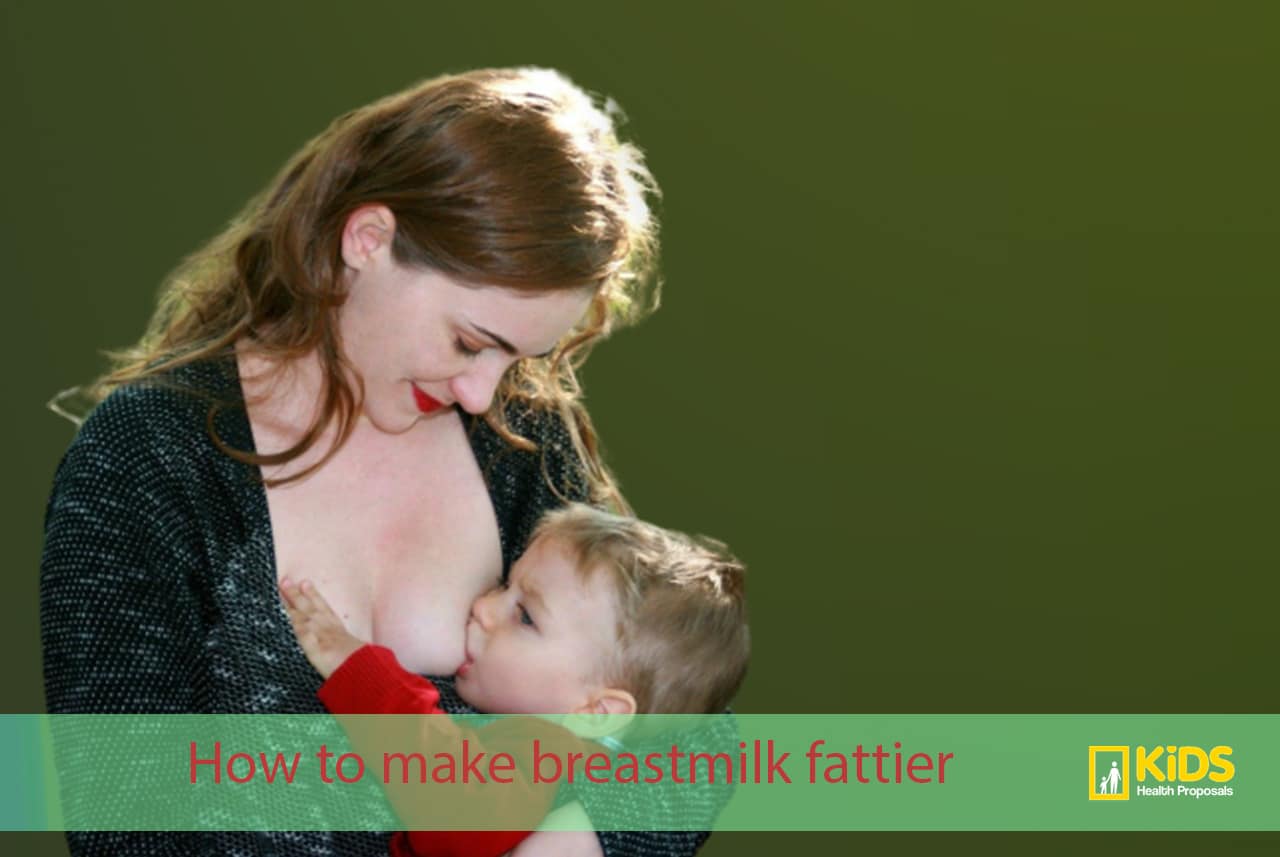How to make breastmilk fattier?
How to make breastmilk fattier, the fat in breast milk is a treasure. Infants who do not drink the fatty portion of breast milk are not satiated. Your milk being fatty provides a feeling of satiety, which increases the saturation of your baby. To improve the quality of breast milk, we have written you a few clues. How to make breastmilk fatty and How do you know if baby isn’t getting enough milk? We know you have lots questions about breastfeeding. Lets go deep into our article for answers and clues..
“Do I have enough breast milk?” The question often worries new moms – but if your baby is growing healthy and well, then probably everything is fine. However, if you are concerned about your breast milk production, it’s important to get early advice. If everything is fine, this will calm you down quickly. It also prevents you from giving your baby unnecessary baby food that can reduce your own production of fat milk.
How can I make my breast milk more fatty?

It is very important to eat regularly and not to be hungry in order to make breast milk more fatty. Therefore, there is no room for long intervals in breastfeeding mother feeding. The nursing mother should have frequent meals to increase fat in milk. In addition, it is very important to get basic foods such as vegetables, fruits, yoghurt and meat in each meal.
For the quality of breast fat milk, it is recommended to eat rich in protein and consume lots of green leafy vegetables. For the quality of breast milk, taking high nutritional foods such as dried figs, dates, almonds, walnuts, hazelnuts and plenty of liquid consumption are also very valuable. Let’s list the foods that increase the quality of breast milk and the foods that decrease the quality of breast milk.
Furthermore, adding more healthy fats to the diet can also increase the quality of breast milk. Foods that are high in healthy fats include avocados, fatty fish, nuts, seeds, and healthy oils such as olive oil or coconut oil. These foods can help provide essential nutrients for both the mother and the baby, including omega-3 fatty acids that are important for brain development.
On the other hand, consuming certain foods and beverages may decrease the quality of breast milk. For example, alcohol consumption can lead to a decrease in milk production and can also pass into the breast milk, which can harm the baby’s development. Similarly, caffeine can also pass into breast milk and may cause irritability or poor sleep in the baby. Foods that are high in saturated fats, such as processed meats and fried foods, may also negatively impact the quality of breast milk and should be consumed in moderation.
Relevant post >> Can you eat deviled eggs while pregnant?
How to make breastmilk fatty?
There are some nutrients that, with their rich ingredients, meet exactly this need for both breastfeeding mothers and babies. It increases the fat of breast milk even more. Furthermore, consuming foods that are high in these nutrients can also help increase breast milk supply. You can Make your breastmilk fattier but how? What are those foods?
High protein foods such as meat, fish and organic chickens
- Yogurt, egg
- Molasses, honey, or tahini
- Compote
- Dried fruits
- Nuts
- Green leafy vegetables
- Fruits
Bad For Breastfeeding Mothers
- high caffeine
- Carbonated drinks
- Heavy alcoholic drinks
Eggs: You should eat eggs every morning to make your milk even fatter. Eggs have a lot of iodine, zinc, protein and A, C, E vitamins. The most valuable nutrient that contributes to your baby’s brain development and supports the quality of your milk.
Yogurt: For fatty breast milk, you should eat yogurt. A bowl of yogurt every day meets your calcium and phosphorus needs for you and your baby. Yogurt is important for your dental health. Consuming a daily bowl of yogurt can provide important nutrients such as calcium and phosphorus, improve dental health, and help increase breast milk supply and fat content.
Green leafy vegetables: Eating green leafy vegetables for nursing mothers helps milk and milk increase fat. You need to take 1300 ml of calcium a day. You can get the calcium you need from skim milk, yogurt, cheese, green leafy vegetables.
Nuts: Each of the nuts has a great importance for human health. These snacks, which are especially beneficial for expectant mothers, affect the baby’s development when consumed correctly and balanced. Therefore, mother candidates should consume a handful of dried nuts every day. Cashew, pumpkin seeds, chickpeas, pistachios, dried figs, apricots and almonds are coming.
Compote : Breast milk is the most important nutrient that babies must get in the first years of their lives. The better the quality of milk, the better the nutrition and development of the baby. Experts warn that the breastfeeding mother needs to pay attention to her diet at least as much as she does during pregnancy. A nursing mother needs to consume nutrients that will contribute to breast milk and drink milk-enhancing drinks.
One of the drinks that increase breast milk and positively affects the quality of milk is the compote that increases milk.
Don’t Drink Them When Breastfeeding For Fattier Breastmilk
High caffeine: How difficult has it been to be separated from her since pregnancy, right? However, while breastfeeding, you should consume caffeine, coffee and chocolate limited; because it can lead to insomnia and restlessness in infants. You have to settle for one or two small cups of coffee a day.
Alcohol : As the amount of alcohol entering
Breastfeeding is a crucial time for a newborn baby to receive all the necessary nutrients and antibodies for growth and development. As a nursing mother, it is important to pay close attention to what you consume, as it can directly impact your breast milk’s quality and quantity.
There are various myths surrounding the types of foods or drinks that a nursing mother should consume to produce fattier breast milk. However, one of the most common misconceptions is that drinking certain types of beverages, such as beer, can increase the fat content in breast milk. In reality, this is not true.
While some studies have suggested that beer consumption can increase prolactin levels, which is the hormone responsible for milk production, it does not necessarily increase the fat content in breast milk. In fact, drinking alcohol while breastfeeding can have harmful effects on the baby’s health.
When a nursing mother consumes alcohol, it enters her breast milk and can cause the baby to become drowsy, dehydrated, and affect their feeding pattern. It can also lead to a decrease in milk supply, which can have long-term effects on the baby’s growth and development. Additionally, alcohol consumption can also interfere with a baby’s cognitive and behavioral development, leading to developmental delays.
Moreover, drinking beer or any other alcoholic beverage can cause a host of health issues for the nursing mother, including dehydration, increased risk of breast cancer, and liver disease. It can also impair the mother’s cognitive and motor skills, which can impact her ability to care for her baby safely.
Apart from alcohol, other beverages such as coffee and tea can also have a negative impact on breast milk quality and quantity. Consuming too much caffeine can lead to dehydration and cause the baby to become fussy or irritable. It can also interfere with the baby’s sleep pattern, which can have long-term effects on their growth and development.
Instead, nursing mothers should focus on consuming a well-balanced diet that includes a variety of nutrient-dense foods. Eating foods that are high in healthy fats, such as avocados, nuts, and seeds, can help increase the fat content in breast milk. Additionally, consuming foods that are rich in protein, iron, and calcium can provide the baby with the necessary nutrients for growth and development.
It is also important for nursing mothers to stay hydrated by drinking plenty of water and other non-caffeinated beverages. This can help increase milk supply and prevent dehydration, which can have a negative impact on breast milk quality and quantity.
In conclusion, nursing mothers should avoid consuming alcohol, caffeine, and other unhealthy beverages while breastfeeding. These substances can have a negative impact on both the mother and baby’s health and development. Instead, nursing mothers should focus on consuming a well-balanced diet and staying hydrated to produce high-quality breast milk that provides the necessary nutrients for their baby’s growth and development.
the bloodstream increases, the likelihood of passing to the baby through breastfeeding increases. Although the amount transferred to the baby is relatively small when you drink a glass of wine, your baby has a tiny and immature liver. This means that it cannot process alcohol well enough. Babies under the age of 3 months can process about half the alcohol.
It is important for the breastfeeding mother to improve the quality of the milk, but it is very important to drink every drop of breast milk to the baby. For this reason, the mother can hide milk by pumping it when she cannot be with her baby.
You can provide your milk comfortably when you cannot be with your baby. After pumping it, you can put it in breast milk storage bottles or storage bags and write your name and pumping date in the refrigerator. We wrote an article about how to make breastmilk fattier. You can leave a comment for it.
How do you know if baby isn’t getting enough milk?
Your baby may not get enough breastmilk for a few weeks after birth. If you are not breastfeeding frequently or have low milk, your baby is not saturated and the symptoms that show how do you know this are listed below.
Low weight gain: In the first week, babies do not gain weight and even lose weight, this is normal. If he doesn’t gain weight after a week, the baby must be starving. If your baby has lost 10% or more of his birth weight or has not gained weight after a week, you should see a doctor immediately.
Number of diapers: Unsaturated babies do not wet their diapers. Newborn baby mothers change their babies’ diapers 7 times a day. If your baby’s diaper is dry or if you change it less than 5 times a day, the baby is not getting enough milk
Dehydration. If your baby has dark urine, a dry mouth or jaundice (yellow skin or eyes) or is lethargic and reluctant to drink, he may be dehydrated. High Fever, diarrhea and vomiting or overheating can cause dehydration in babies. If you notice any of these symptoms, contact a doctor quickly.
Newborns usually drink very often – about ten to twelve times a day or every two hours – and that doesn’t mean you don’t have enough milk.
How to Increase Milk Supply When Pumping?
If you need to stimulate and increase milk production in the first few days after birth, you can use an electric breast pump. This type of pump is designed to mimic the baby’s sucking behavior while breastfeeding and has been shown to increase long-term milk production. Using an electric breast pump can help stimulate milk production and ensure that breast milk begins to flow during the first few days after birth, making it easier to establish and maintain breastfeeding.
As soon as your milk is injected, you will pump up from both sides and get more milk in less time. This method also empties the breast better, which promotes your milk production.
Although each mother is different, it is usually a good idea to empty the milk immediately or an hour after breastfeeding. This may seem unreasonable as it is often easier to pump a full nozzle. However, you should consider pumping the “milk order” for the next day.
There may be only small amounts at the beginning, but you can be sure – the amount increases with regular pumping. Try to take milk eight to twelve times a day (through breastfeeding and pumping), including the night when the milk-producing hormone prolactin is highest. The more milk is drawn, the better. After two or three days of regular pumping, you should notice a significant increase in your milk production
Breast milk is discussed into three phases: colostrum, transition milk and mature breast milk.

Phase 1: The colostrum – also starting milk, pre-milk
Colostrum (Latin colostrum) is the first food for the baby. It is produced in the breasts during the final months of pregnancy and immediately after birth.
Colostrum is a yellow, creamy, viscous milk, very easy to digest and particularly valuable due to the high content of immune defenses.
Compared to mature milk, it contains more proteins e.g. Antibodies, less fat and less sugar, minerals like zinc, vitamins like vitamin A, E, vitamins from the B complex and many immunoglobulins and IgA.
IgA is responsible for 80% of the immune defense and accounts for 50% of the total protein in breast milk. Together with the other immune factors, they protect the newborn from infections and diseases.
Colostrum helps the baby cleanse the digestive tract from the first greenish black stool (infant pitch) that has accumulated in the intestine before birth.
When the baby drinks colostrum, it stimulates the mother’s milk-producing glands, the milk flow reflex, and prepares the child’s organs for digestion. This protects the child from unwanted bacteria and organisms.
The more often you put the baby on and breastfeed, the faster the transition milk is formed. The transition to mature milk takes about up to two weeks after birth.
Phase 2: transition milk
The transition milk is watery and shimmers blue-white. It contains less protein, but more carbohydrates and fat.
Phase 3: The mature breast milk
The mature breast milk is white or bluish-white and very rich in protein (approx. 1.2%), water, unsaturated fatty acids, vitamins and folic acid. The watery pre-milk quenches the thirst, the post-milk with increased fat and protein content is supposed to satisfy the baby’s hunger
FAQ
What foods fatten up breast milk?
There are no specific foods that can “fatten up” breast milk, but a well-balanced and nutritious diet can help support milk production and provide essential nutrients for the baby’s growth and development. Eating a variety of whole foods, including lean proteins, fruits, vegetables, whole grains, and healthy fats can help ensure that the breast milk is nutritious and adequate for the baby’s needs. Some breastfeeding women also find that certain foods, such as oats, flaxseed, and fenugreek, can help boost milk production, but it is always important to talk to a healthcare provider before taking any supplements or making significant changes to the diet.
Why isn’t my breast milk fatty?
Breast milk is naturally designed to provide the right amount of nutrients and fats for the baby’s needs. However, the amount of fat in breast milk can vary depending on factors such as the mother’s diet, the baby’s age and feeding habits, and the frequency of nursing. If you are concerned that your breast milk may not be fatty enough, it is best to speak with a lactation consultant or healthcare provider who can help determine the cause and provide guidance on how to increase the fat content.
What time of day is breast milk the fattiest?
Breast milk’s fat content tends to be the highest in the morning hours, particularly between the hours of 2 and 5 a.m. This is because during the night, the body produces more of the hormone prolactin, which stimulates milk production and can result in a higher fat content.
Is there a way to thicken breast milk?
Breast milk is naturally produced by the mother’s body and the composition cannot be altered. However, there are some things that can affect the consistency of breast milk, such as a mother’s diet and hydration levels. Drinking plenty of water and eating a balanced diet can help ensure the best quality breast milk production. In some cases, feeding the baby more frequently or for longer periods of time on each breast can also help increase the fat content of the milk. It is important to consult with a lactation consultant or healthcare provider if there are any concerns about the baby’s feeding or milk production.
How long does it take to get hindmilk?
It typically takes 10-20 minutes of breastfeeding to reaching the hindmilk, depending on factors such as the baby’s age and how frequently they feed.
Is it OK that my breast milk is watery?
Yes, it is normal for breast milk to vary in consistency, and it can be watery at times. The watery milk is known as foremilk, which comes out at the beginning of a feeding session, and it is rich in protein, sugar, and vitamins. Hindmilk is the milk that comes out towards the end of a feeding session, and it is richer in fat, which helps your baby feel full and gain weight. It is important to make sure your baby is feeding long enough on each breast to get both foremilk and hindmilk. If you have concerns about the consistency or quality of your breast milk, it is best to talk to a lactation consultant or your healthcare provider.
What happens if a baby gets too much foremilk?
If a baby gets too much foremilk, which is the milk that comes first in a feeding, they may get too much lactose, which can cause them to be gassy, fussy, and have green, watery stools. They may also not feel full after a feeding and want to nurse more frequently. However, it is important to note that some mothers may naturally have a higher proportion of foremilk to hindmilk, and as long as the baby is gaining weight and having normal bowel movements, the breast milk is likely providing the nutrients they need. It is best to talk to a healthcare provider or lactation consultant if you have concerns about your baby’s feeding.
Our previous article What does white nipples mean when breastfeeding? in the title How can I treat mastitis at home, nipple pain ve white dot on nipple breastfeeding information is provided..

Hello, I’m Dorothy. I love writing and researching articles. Reading books about baby health, care and pregnancy is my favorite. I will be sharing delicious and healthy information on food and baby food during pregnancy.












Thank you for sharing your insight! Helpful!
Great article!
Great website. Very helpful!